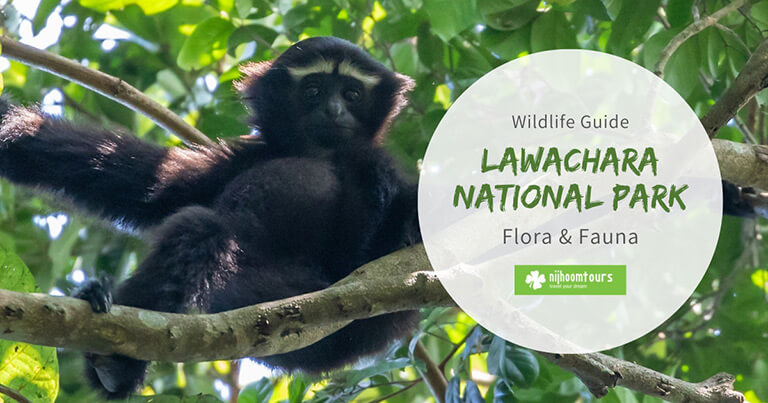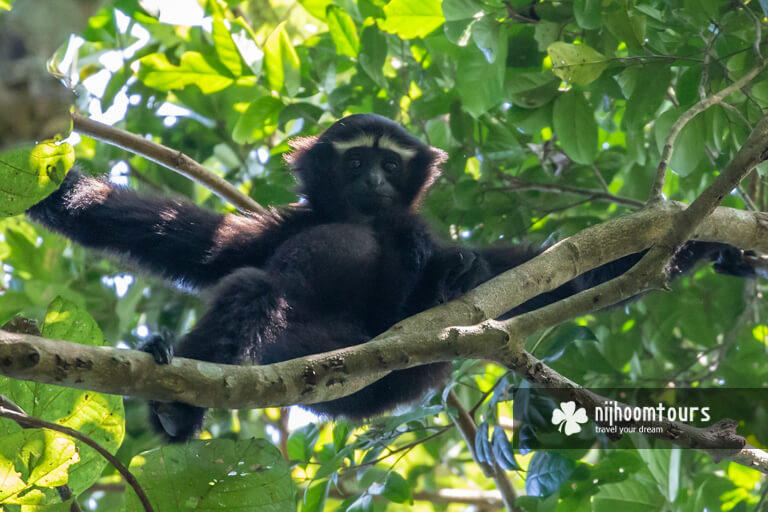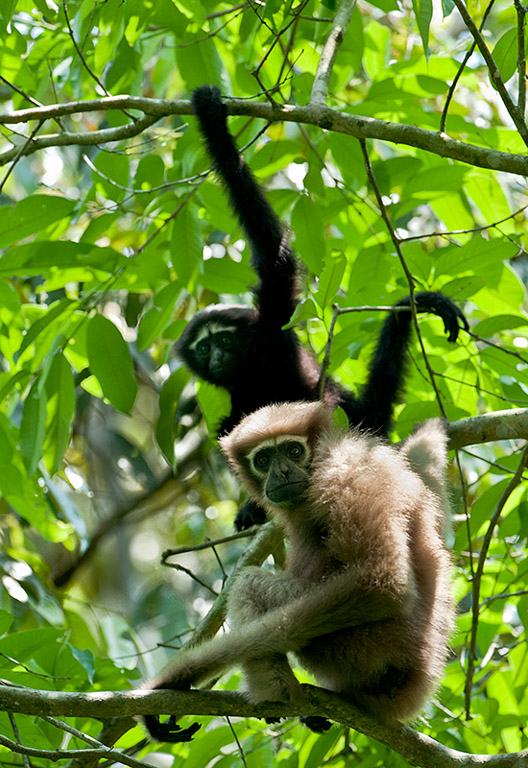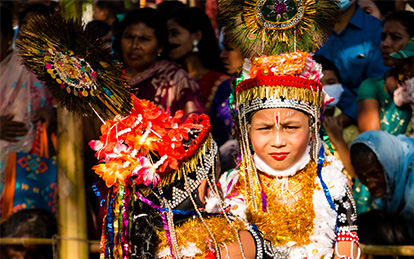
Discover the incredible variety of plant and animal life that can be found at Lawachara National Park in Sreemangal, Bangladesh. Know details about its mammals and primates.
The Lawachara National Park is a beautiful and biodiverse area in northeastern Bangladesh. The park spans over 1,250 hectares and is home to many different types of plants and animals, making it a haven for nature lovers and researchers. This protected area is a testament to the country’s dedication to preserving its natural heritage, from lush tropical forests to endangered species.
The park’s most prominent feature is its evergreen tropical rainforest, one of the last remaining in Bangladesh. As you venture into the lush greenery, you’ll be greeted by towering trees, forming a dense canopy that filters sunlight, creating a mystical atmosphere below. The air is filled with the sweet aroma of blooming flowers, and the symphony of birdsong echoes through the trees. It’s a place where time seems to slow down, and one can truly reconnect with nature.
Lawachara National Park allows visitors to discover its natural beauty by following its well-kept trails and walkways. One of the most commonly traveled paths is the 1.5-kilometer-long Lawachara Trail, which takes you deep into the forest’s heart and provides an up-close look at its breathtaking biodiversity. This article will provide a detailed discussion of the flora and fauna found in Lawachara National Park.
Table of Contents
- Flora of Lawachara National Park
- Fauna of Lawachara National Park
- Mammals of Lawachara National Park
- Primates of Lawachara National Park
- Visiting Sreemangal
Flora of Lawachara National Park
Lawachara National Park has an impressive collection of plant species, including many rare and endemic varieties. The forest canopy is dominated by towering dipterocarps, such as the Garjan (Dipterocarpus turbinatus), which reach over 70 meters. Other prominent tree species include the Chalta (Dillenia pentagyna), Nahar (Mesua ferrea), and Jarul (Lagerstroemia speciosa). These majestic trees provide habitat, food, and shelter for many organisms.
The forest floor is adorned with a diverse understory of shrubs, herbs, and climbers. Ferns, mosses, and orchids thrive in the humid environment, creating a picturesque landscape. The park is renowned for its orchid diversity, with over 100 species recorded. These delicate and colorful flowers add a touch of elegance to the forest floor.
▲ Back to the Table of Contents
Fauna of Lawachara National Park
Lawachara National Park teems with animal life, including several endangered and rare species. The park is renowned for being the habitat of the critically endangered Western Hoolock gibbon (Hoolock hoolock), a primate known for its distinct songs and incredible agility in the trees. Other primate species in the park include the Phayre’s langur (Trachypithecus phayrei) and capped langur (Trachypithecus pileatus).
Lawachara National Park is a birdwatcher’s paradise with a rich avian population. Over 246 bird species have been documented, including rare and endemic species. The park is home to spectacular hornbill species like the great hornbill (Buceros bicornis), wreathed hornbill (Rhyticeros undulatus), and rufous-necked hornbill (Aceros nipalensis). Other notable bird species include the blue-bearded bee-eater (Nyctyornis athertoni), Blyth’s kingfisher (Alcedo hercules), and green cochoa (Cochoa viridis).
Lawachara National Park is also a haven for various mammal species. The elusive clouded leopard (Neofelis nebulosa), an apex predator, finds refuge within these forests. Other carnivores, such as the leopard cat (Prionailurus bengalensis) and Asian golden cat (Catopuma temminckii), roam the park’s wilderness. In addition, the park is home to numerous deer species, including the Indian muntjac (Muntiacus muntjak) and barking deer (Muntiacus vaginalis).
Reptiles and amphibians also contribute to the park’s biodiversity. Numerous snake species, including the King cobra (Ophiophagus hannah) and Indian python (Python molurus), can be found within the dense foliage. Various frog species, such as the Asian horned frog (Megophrys nasuta) and Boulenger’s bubble-nest frog (Raorchestes boulengeri), add their unique chorus to the park’s symphony of sounds.
▲ Back to the Table of Contents

A male Hoolock Gibbon at Lawachara National Park in Sreemangal. © Photo Credit: Eric Lynn.
Mammals of Lawachara National Park
A research paper by Md. Abdul Aziz, Department of Zoology, Jahangirnagar University, published in 2011, presents a comprehensive checklist of mammalian species found in Lawachara National Park in Bangladesh. It provides valuable insights into their current status and identifies the conservation threats they face. The study documented a total of 39 mammal species, which were classified into seven orders and 21 families. Among these, the significant orders were Carnivora (38%), Rodentia (24%), Primates (15%), Chiroptera (13%), and Artiodactyla (5%).
The study categorized the recorded mammal species based on their population abundance, with 36% considered common, 26% uncommon, 23% rare, and 15% very common. On a national scale, 51% of the recorded species faced various threats, while 28% were not threatened, and 21% had insufficient data to determine their status. Globally, 23% of the species were identified as threatened, while 73% fell into the lower-risk category.
The paper highlights that primates, herbivores, and carnivores are particularly vulnerable to severe threats, primarily habitat loss and fragmentation, wildlife poaching, and human disturbance. To ensure the long-term conservation of mammalian species in Lawachara National Park, urgent actions must be taken. These include addressing illegal tree felling and the over-exploitation of forest resources, restoring degraded habitats, and regulating tourism activities. These measures are essential for mitigating the threats and protecting the diverse mammalian species inhabiting the park.
The list of mammals at Lawachara National Park follows:
- House Shrew (Suncus murinus) – Chika/Chucho (C, NT)
- Short-nosed Fruit Bat (Cynopterus sphinx) – Bocha Kola Badur (V, DD)
- Indian Flying Fox (Pteropus giganteus) – Badur (V, NT)
- Fulvus Fruit Bat (Rousettus leschenaulti) – Kola Badur (C, DD)
- Greater False Vampire (Megaderma lyra) – Daini Badur (V, NT)
- India Pipistrelle (Pipistrellus coromandra) – Chamchika (C, NT)
- Bengal Slow Loris (Nycticebus bengalensis) – Lojjawati Banor (R, CR)
- Rhesus macaque (Macaca mulatta) – Banor (V, VU)
- Northern Pig-Tailed Macaque (Macaca leonina) – Ultoleji Banor (C, CR)
- Phayre’s Leaf Monkey (Trachypithecus phayrei) – Chosmapora Hanuman (U, CR)
- Capped Langur (Trachypithecus pileatus) – Mukhpora Hanuman (C, EN)
- Western Hoolock Gibbon (Hoolock hoolock) – Ulluk (V, EN)
- Asiatic Golden Jackal (Canis aureus) – Pati Shial (C, VU)
- Jungle Cat (Felis chaus) – Ban Biral (U, EN)
- Leopard Cat (Prionailurus bengalensis) – Chita Biral (U, DD)
- Fishing Cat (Prionailurus viverrinus) – Mecho Biral (C, EN)
- Clouded Leopard (Neofelis nebulosa) – Gecho Bagh (R, CR)
- Small Indian Mongoose (Herpestes auropunctatus) – Benji (C, NT)
- Common Mongoose (Herpestes edwardsi) – Bara Benji (C, VU)
- Crab-eating Mongoose (Herpestes urva) – Kakrabhuk Benji (R, EN)
- Asiatic Black Bear (Ursus thibetanus) – Kalo Bhalluk (R, EN)
- Binturong (Arctictis binturong) – Gecho Bhalluk (R, CR)
- Masked Palm Civet (Paguma larvata) – Ghanda Gokul (R, EN)
- Common Palm Civet (Paradoxurus hermaphroditus) – Ghanda Gokul (R, VU)
- Large Indian Civet (Viverra zibetha) – Bagdash (U, EN)
- Small Indian Civet (Viverricula indica) – Khatash (U, VU)
- Yellow-throated Marten (Martes flavigula) – – (P, -)
- Wild Boar (Sus scrofa) – Shuar (V, NT)
- Barking Deer (Muntiacus muntjak) – Maya Harin (U, EN)
- Irrawardy Squirrel (Callosciurus pygerythrus) – Badami Kathbirali (V, NT)
- Orange-bellied Himalayan Squirrel (Dremomys lokriah) – Kalo Kathbirali (V, DD)
- Hodgon’s Giant Flying Squirrel (Petaurista magnificus) – Uranta Kathbirali (R, DD)
- House Mouse (Mus musculus) – Nengti Indur (C, NT)
- Common House Rat (Rattus rattus) – Indur (C, NT)
- Asiatic Long-tailed Climbing Mouse (Vandeleuria oleracea) – Gecho Idur (U, DD)
- Lesser Bandicoot Rat (Bandicota bengalensis) – Indur (U, NT)
- Greater Bandicoot Rat (Bandicota indica) – Baro Indur (U, NT)
- Indian Crested Porcupine (Hystrix indica) – Shojaru (C, EN)
- Rufous-tailed Hare (Lepus nigricollis) – Khargosh (U, EN)
C = Common, V = Very Common, R = Rare, U = Uncommon, NT = Not Threatened, DD = Data Deficient, CR = Critically Endangered, VU = Vulnerable, EN = Endangered
▲ Back to the Table of Contents
Primates of Lawachara National Park
Among the mammals, Lawachara National Park is home to five different primates, most of whom are endangered. It is renowned for being the habitat of the endangered Western Hoolock Gibbon (Hoolock hoolock), the only ape found in South Asia. Other primate species in the park include the Capped Langur (Trachypithecus pileatus ), Phayre’s Leaf Monkey (Trachypithecus phayrei), Northern Pig-Tailed Macaque (Macaca leonina), Bengal Slow Loris (Nycticebus bengalensis), and Rhesus macaque (Macaca mulatta). Following are the details on them.

A female (front) and male (back) Western Hoolock Gibbon. © Photo Credit: Vijay Cavale / Wikipedia.
1. Western Hoolock Gibbon (Hoolock hoolock)
– Ulluk (Very Common, Endangered)
Bangladesh is home to one seriously endangered higher primate, the hoolock gibbon. The hoolock is a unique primate. It is the only ape in South Asia. Together with the South-East Asian gibbons, they are called “lesser apes” or “small apes” since they are significantly smaller than the great apes; chimpanzees, orangutans, gorillas, and bonobos.
However, the hoolock is also very different from the other gibbons; the genetic difference between the species is as big as that between humans and chimpanzees. The hoolock has a different chromosome number, their songs are different from other gibbons, and they have the poorest survival in captivity of all the gibbons.
Distribution & Population
This Western Hoolock Gibbon is found in eastern Bangladesh, northeastern India (Arunachal Pradesh, Assam, Manipur, Meghalaya, Mizoram, Nagaland, and Tripura), and northwestern Myanmar (west of the Chindwin River). Western Hoolock Gibbons are globally endangered. They are nationally listed as critically endangered, with generally declining population trends.
There are less than 2,600 individuals of Hoolock hoolock in India, mainly in Assam. Myanmar’s population is not studied. A 2021 research estimated the Bangladesh population to be 469-514 in 135 groups. The Lawachara National Park population was determined to be 40 individuals in 13 groups.
Behavior & Diet
Like other gibbons, the hoolock is an arboreal and diurnal species. It prefers the forest’s upper canopy, sleeping and resting in emergent trees. Hoolocks eat mostly fruits (51-89%), with the leading supplement being leaves (6-32%); hoolocks also consume smaller quantities of flowers and insects. Among fruits, figs appear to be the most important food item, making up about 60% of the fruits consumed by hoolocks and about 38% of their total diet.
Gibbons play central roles in seed dispersal and forest regeneration due to their frugivorous diets. They generally avoid descending to the forest floor, and their brachiating movement requires a contiguous forest with a closed canopy tree structure.
Breeding & lifecycle
Gibbons are monogamous and live their whole adult lives with one partner and all the dependent offspring in a defended territory. Monogamy limits breeding opportunities in fragmented populations, as young gibbons experience difficulty finding a partner. Gibbons do not reproduce before they have a stable partner and a territory of their own, and both males and females in small populations might thus remain “single” their whole lives and contribute nothing to the following generation.
Gibbons give birth to single offspring. Birth typically occurs from November to February. The birth interval in gibbons is about 2-3 years. Young gibbons are born with virtually hairless ventral parts and must rely on their mothers for warmth.
Gibbons also differ from monkeys in that they have a much longer childhood. The gibbon infant’s development is as slow as that of a human child during the first years, and the baby will cling to its mother and breastfeed for more than 2 years. After this, the young animal will remain in his parent’s care for another 5-6 years, learning from them how to live and survive amongst the treetops.
Like humans, the hoolock will start looking for a partner and a new home upon reaching adulthood, which in gibbons occurs when they are around 8 years old. At maturity, offspring probably leave the natal group or may be chased off by their parents. Their life expectancy in captivity is perhaps up to 50 years, but hoolocks have rarely survived in captivity for more than a few years.
References
- The IUCN red list of threatened species
- The Endangered Hoolock Gibbon of Bangladesh
- The Gibbon Network
▲ Back to the Primates | Mammals | Table of Contents
Visiting Sreemangal
Planning to visit Sreemangal? We can help organize a memorable holiday in Sreemangal for you to experience the best of it, including a wildlife trek through the Lawachara National Park. We are an award-winning local tour operator in Bangladesh specializing in organizing tours and holidays in Bangladesh for Western travelers, with 375+ reviews on TripAdvisor with an average rating of 5/5. Check out our Sreemangal tour packages to see what we can organize for you there. Contact us now for your memorable Sreemangal holiday!
Check out our 1-7 days Bangladesh tour packages and 8-28 days Bangladesh holiday packages to visit Bangladesh with comfort.
Share This
Share this article with friends by clicking any button below. Let them know about amazing Bangladesh, which is one of the least traveled destinations in the world. Share now!















